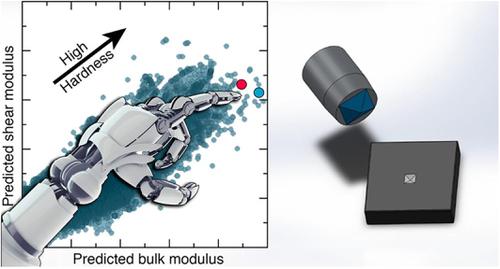当前位置:
X-MOL 学术
›
WIREs Comput. Mol. Sci.
›
论文详情
Our official English website, www.x-mol.net, welcomes your
feedback! (Note: you will need to create a separate account there.)
Machine learning and artificial neural network accelerated computational discoveries in materials science
Wiley Interdisciplinary Reviews: Computational Molecular Science ( IF 16.8 ) Pub Date : 2019-11-20 , DOI: 10.1002/wcms.1450 Yang Hong 1 , Bo Hou 2 , Hengle Jiang 3 , Jingchao Zhang 3
Wiley Interdisciplinary Reviews: Computational Molecular Science ( IF 16.8 ) Pub Date : 2019-11-20 , DOI: 10.1002/wcms.1450 Yang Hong 1 , Bo Hou 2 , Hengle Jiang 3 , Jingchao Zhang 3
Affiliation

|
Artificial intelligence (AI) has been referred to as the “fourth paradigm of science,” and as part of a coherent toolbox of data‐driven approaches, machine learning (ML) dramatically accelerates the computational discoveries. As the machinery for ML algorithms matures, significant advances have been made not only by the mainstream AI researchers, but also those work in computational materials science. The number of ML and artificial neural network (ANN) applications in the computational materials science is growing at an astounding rate. This perspective briefly reviews the state‐of‐the‐art progress in some supervised and unsupervised methods with their respective applications. The characteristics of primary ML and ANN algorithms are first described. Then, the most critical applications of AI in computational materials science such as empirical interatomic potential development, ML‐based potential, property predictions, and molecular discoveries using generative adversarial networks (GAN) are comprehensively reviewed. The central ideas underlying these ML applications are discussed, and future directions for integrating ML with computational materials science are given. Finally, a discussion on the applicability and limitations of current ML techniques and the remaining challenges are summarized.
中文翻译:

机器学习和人工神经网络加速了材料科学中的计算发现
人工智能(AI)被称为“科学的第四范式”,并且作为数据驱动方法的连贯工具箱的一部分,机器学习(ML)极大地加速了计算发现。随着用于ML算法的机器的成熟,不仅主流AI研究人员,而且在计算材料科学领域的研究人员都取得了长足的进步。机器学习和人工神经网络(ANN)在计算材料科学中的应用数量正以惊人的速度增长。此观点简要回顾了一些受监督和无监督方法及其各自应用程序的最新进展。首先描述主要的ML和ANN算法的特征。然后,全面回顾了AI在计算材料科学中的最关键应用,例如经验性原子间电势发展,基于ML的电势,性质预测和使用生成对抗网络(GAN)的分子发现。讨论了这些ML应用程序背后的中心思想,并给出了将ML与计算材料科学集成的未来方向。最后,总结了有关当前机器学习技术的适用性和局限性以及其余挑战的讨论。并给出了将ML与计算材料科学相集成的未来方向。最后,总结了有关当前机器学习技术的适用性和局限性以及其余挑战的讨论。并给出了将ML与计算材料科学相集成的未来方向。最后,总结了有关当前机器学习技术的适用性和局限性以及其余挑战的讨论。
更新日期:2019-11-20
中文翻译:

机器学习和人工神经网络加速了材料科学中的计算发现
人工智能(AI)被称为“科学的第四范式”,并且作为数据驱动方法的连贯工具箱的一部分,机器学习(ML)极大地加速了计算发现。随着用于ML算法的机器的成熟,不仅主流AI研究人员,而且在计算材料科学领域的研究人员都取得了长足的进步。机器学习和人工神经网络(ANN)在计算材料科学中的应用数量正以惊人的速度增长。此观点简要回顾了一些受监督和无监督方法及其各自应用程序的最新进展。首先描述主要的ML和ANN算法的特征。然后,全面回顾了AI在计算材料科学中的最关键应用,例如经验性原子间电势发展,基于ML的电势,性质预测和使用生成对抗网络(GAN)的分子发现。讨论了这些ML应用程序背后的中心思想,并给出了将ML与计算材料科学集成的未来方向。最后,总结了有关当前机器学习技术的适用性和局限性以及其余挑战的讨论。并给出了将ML与计算材料科学相集成的未来方向。最后,总结了有关当前机器学习技术的适用性和局限性以及其余挑战的讨论。并给出了将ML与计算材料科学相集成的未来方向。最后,总结了有关当前机器学习技术的适用性和局限性以及其余挑战的讨论。











































 京公网安备 11010802027423号
京公网安备 11010802027423号